
 |
|
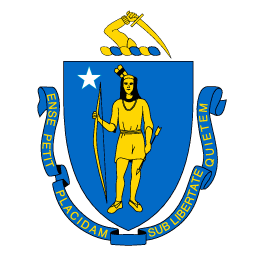













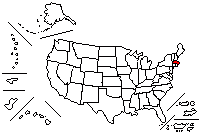
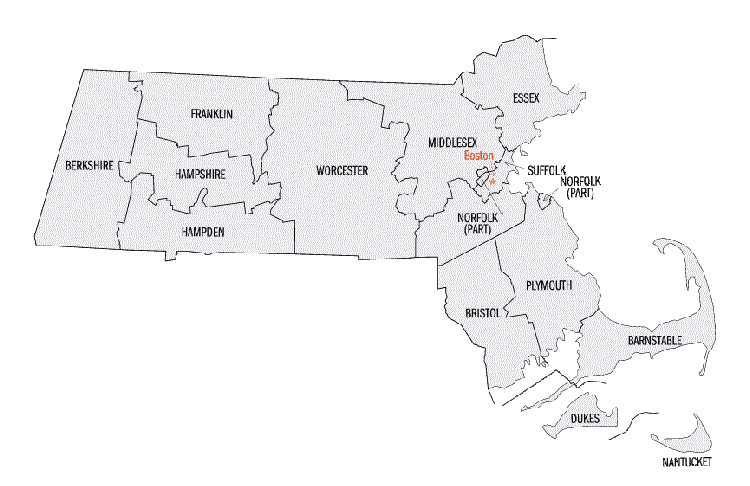

All Hail To Massachusetts |
Saluden a Massachusetts escrito por Arturo J. Marsh Saluden a Massachusetts, la tierra de la libertad y del valiente! Por Bunker Hill y Charlestown, y la bandera que amamos ondear; Por Lexington y Concord, y el disparo se oyó alrededor del mundo; Saluden a Massachusetts, mantendremos su bandera desplegada. Ella está de pie por la luz de la libertad que brilla de mar a mar; Saluden a Massachusetts! Nuestra patria esto es por tí! Todos saluden al gran viejo estado de bahía, al hogar del haba y del bacalao, donde los peregrinos encontraron una entrada y dieron sus gracias a Dios. Una tierra de oportunidad en el buen viejo E.E.U.U.. Donde los hombres viven mucho y prosperan, y la gente viene a quedarse. No vender todo sino aprender de su industria y progreso; Todos saluden al viejo y magnífico estado de la bahía! La tierra del orgullo del peregrino! Saluden a Massachusetts, renombrado en el salón de la fama! Como orgullosamente ondemos su bandera blasonadas con su nombre! En la unidad y la fraternidad, los hijos y las hijas entran tomados de la mano; Todos Saluden a Massachusetts, no hay tierra más fina! Es M-A-S-S-A-C-H-U-S-E-T-T-S. Todos Saluden a Massachusetts! Todos Saluden! Todos Saluden! Todos Saluden! |

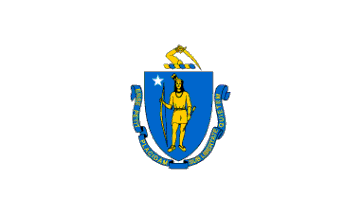
Flag:
From the 18th century, Massachusetts used a white flag with its coat of arms in the center. In 1915
this was legally established as the state flag. On the front was the blue shield with the indian holding a bow and arrow.
A ribbon with the state motto was around the shield, and an arm holding a sword was used as a crest. Since flags
were hand painted in 1915, the reverse was made to be more simple: a green tree was painted in the middle of the
shield, no ribbon, no motto, no crest. By 1971 this had become an expensive flag to manufacture, so Whitney Smith
of the Flag Research Center had his legislator introduce a law to re-define the state flag to make it same on front and back.
The silver star next to the Native American was made "white" so as to avoid printing another color.
The green pine tree was taken off the reverse of the flag and placed on a white field to re-create the Massachusetts
maritime flag, just like the one used during the late 18th century Revolutionary War.
On a white field is a blue shield emblazoned with the image of a Native American,
Massachuset. He holds a bow in one hand and an arrow in the other. The arrow is
pointing downward representing peace. The white star represents Massachusetts as
one of the original thirteen states. Around the shield is a blue ribbon with the
motto:" By the Sword We Seek Peace, but Peace Only Under Liberty".Above the shield
is a arm and sword, representing the first part of the motto. Flag adopted 1915,
amended 1971.
Bandera:
Desde el siglo 18
Massachusetts utilizó una bandera blanca con su escudo de armas en el centro. En el 1915 esta fué la bandera legalmente
establecida por el estado y en el frente de la bandera aparecía el escudo. Desde que la bandera fué pintada a mano en el
1915, el reverso fué hecho más simple: un árbol verde fué pintada en el medio del escudo, sin cinta, sin lema y sin cresta.
En el 1971 hacer esta bandera era costosa entonces Whitney Smith del Centro Investigativo de la Bandera pidió a los legisladores
que redifinieran la bandera para hacerla igual en ambos lados. La estrella plateada al lado del nativo americano se hizo en
blanco para evitar imprimir otro color.
On un fondo blanco está un escudo azul donde aparece la imagen de un nativo americano,
de Massachuset. El sostiene un arco en una mano y una flecha en la otra. La flecha apunta hacia
abajo que representa la paz. La estrella blanca representa a Massachusetts como uno de los
trece estados originales. Al rededor del escudo aparece una cinta azul con el lema: " Por la
espada buscaremos
la paz, pero la paz solo bajo la libertar". Sobre el escudo está un brazo y una espada, representando
la primera parte del lema. Bandera adoptada en el 1915 y enmendada en el 1971.

Massachusetts
Massachusetts (se pronuncia Mas-sa-chú-sets en inglés y español)
Capital City: Boston
National: Bay Staters (officially designated on
December 18, 1990)
Like other New Englanders, Bay Staters are commonly
referred to as Yankees. (massachusets)
Admission to Statehood: February 6, 1788
Border States: Connecticut / New Hampshire / New York / Rhode Island / Vermont
Motto:Ense Petit Placidam Sub Libertate Quietem (“By the Sword We Seek
Peace, but Peace Only under Liberty”)
This motto was first used on the seal commissioned in 1775.
The motto is attributed to Algernon Sydney.
Nickname: Bay State
Origin of state's name: Named by americans after local Indian tribe whose name means
"a large hill place"
Ciudad Capital: Boston (se pronuncia Bós-ton en inglés y español)
Gentilicio: Bahioestadinos (oficializado el 18 de diciembre de 1990)
Anteriormente, al igual que los estados de Nueva Inglaterra, se les decía Yankees de Massachusetts.
Admición como estado: 6 de febrero de 1788
Estados Limítrofes: Connecticut / New Hampshire / New York / Rhode Island / Vermont
Lema: Ense Petit Placidam Sub Libertate Quietem - " Por la
espada buscaremos
la paz, pero la paz solo bajo la libertar". Este lema fué usado primero en el sello de 1775.
Este lema es atribuido a Algernon Sydney.
Cognómento: El Estado Bahía
Origen del nombre: Nombre dado por americanos por una tribu india local cuyo nombre era Masachuset
y que significa "Un sitio de campo grande".

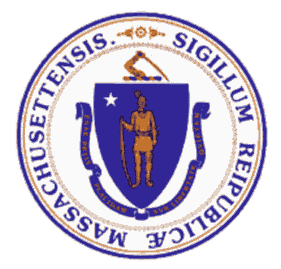
The Seal:
The STATE SEAL, adopted by Governor
The STATE SEAL, adopted by Governor John Hancock and the Council on December 13, 1780 and
made official by the General Court on June 4, 1885, is circular and bears a representation
of the arms of the Commonwealth encircled with the words,
"Sigillum Reipublicae Massachusettensis" (Seal of the Republic of Massachusetts).
The final form of the seal was determined by a statewide contest.
The arms, according to legislative enactment, consist of "a shield having a blue field or surface with an Indian thereon, dressed in a shirt and moccasins, holding in his right hand a bow, and in his left hand an arrow, point downward, all of gold; and, in the upper corner of the field, above his right arm, a silver star with five points. The crest is a wreath of blue and gold, on which in gold is a right arm, bent at the elbow, clothed and ruffled, with the hand grasping a broadsword". The shield's shape is called "Plantagenet"; the Native American model used was of the Algonquin nation; the arrow points downward to indicate that the Indian is peaceful; and the star indicates that Massachusetts was one of the original thirteen states; it was sixth. The sword illustrates the Latin motto that is written in gold on a blue ribbon around the bottom of the shield: "Ense petit placidam sub libertate quietem". This is the second of two lines written about 1659 by Algernon Sydney, English soldier and politician, in the Book of Mottoes in the King's Library in Copenhagen, Denmark. It was adopted in 1775 by the Provincial Congress and means, "By the sword we seek peace, but peace only under liberty".
and the Council on December 13,
1780 and made official by the General Court on June 4, 1885, is circular and bears
a representation of the arms of the Commonwealth encircled with the words,
"Sigillum Reipublicae Massachusettensis" (Seal of the Republic of Massachusetts).
The final form of the seal was determined by a statewide contest.
The arms, according to legislative enactment, consist of "a shield having a blue
field or surface with an Indian thereon, dressed in a shirt and moccasins, holding
in his right hand a bow, and in his left hand an arrow, point downward, all of gold;
and, in the upper corner of the field, above his right arm, a silver star with five
points. The crest is a wreath of blue and gold, on which in gold is a right arm,
bent at the elbow, clothed and ruffled, with the hand grasping a broadsword".
The Native American model used was of the
Algonquin nation; the arrow points downward to indicate that the Indian is peaceful;
and the star indicates that Massachusetts was one of the original thirteen states;
it was sixth. The sword illustrates the Latin motto that is written in gold on a blue
ribbon around the bottom of the shield: "Ense petit placidam sub libertate quietem".
This is the second of two lines written about 1659 by Algernon Sydney, English soldier
and politician, in the Book of Mottoes in the King's Library in Copenhagen, Denmark.
It was adopted in 1775 by the Provincial Congress and means, "By the sword we seek peace,
but peace only under liberty".
El Sello
El Sello del Estado, adoptado por el gobernador John Hancock y el Consejo Estatal el 13 de
diciembre de 1780 y oficializado por la Corte General el 4 de junio de 1885, es circular y
representativo al escudo de armas del estado con la palabras "Sigillum Reipublicae Massachusettensis"
(Sello de la República de Massachusetts). La forma final del sello fué determinado por una
competencia estatal.
El escudo de armas, de acuerdo con la legislatura, consiste de " un escudo en un campo azul
con un indio sobre puesto, vestido con una camisa y mocasines, sujetando en su mano derecha
un arco y en su izquierda una flecha apuntando hacia abajo todo en oro; y en la esquina superior
sobre su mano derecha, una estrella plateada con cinco puntas. La cresta es una espiral de azul
y oro, en el cual tiene un brazo color oro doblado y vestido en frunce. Y con la mano agarrando
un sable. El nativo americano utilizado fué de la Nación Algonquin; las puntas de las flechas
hacia abajo indica que el indio es pacífico; y la estrella indica que Massachusetts fué uno de
los trece estados originales (fué el sexto). La espada ilustra el lema en latín que está
escrito en oro en una cinta azul debajo del escudo: "Ense petit placidam sub libertate quietem".
Esto es la segunda de las dos líneas escritas por 1659 por Algernon Sydney, soldado inlgés
y político, en el libro de Lemas en la librería del Rey en Copenhagen, Dinamarca.
Fué adoptado en el 1775 por el congreso provincial y significa, " Por la espada buscaremos
la paz, pero la paz solo bajo la libertar".

History
Massachusetts is a small state in the northeastern United States
that has made contributions to the nation far greater than its
size might suggest. The state, roughly rectangular in shape, is
the sixth smallest in area. It lies at the center of New England,
with Vermont, New Hampshire, and Maine to the north and Rhode Island
and Connecticut to the south. New York is to the west and the
Atlantic Ocean to the east.
The state, known legally as a commonwealth, was explored in the late
16th and early 17th centuries and was first permanently settled at
Plymouth in 1620. One of the thirteen original states, it was the
sixth to ratify the Constitution. Boston, the capital of Massachusetts,
is the de facto capital of New England.
The name Massachusetts is thought to be of Algonquiano (The Algonquin or Algonkin,
a North American Indian tribe,
inhabited in the 17th century the upper St. Lawrence and the lower Ottawa River
areas of present-day Quebec, Canada) origin and
means "near the great hill." The state has made many contributions
to the nation in its cultural growth, political activities, and
concern for social welfare. Like many of its neighboring states,
Massachusetts is working hard to maintain progress in the face of
recent economic difficulties.
The pre-European population of Massachusetts was a small number
of relatively independent native American tribes. In the late
16th century, European ships explored the New England coast,
led by Giovanni da Verrazano (An Italian navigator and explorer in
France's service, Giovanni da Verrazano, c.1485-c.1528, sailed up the
east coast of North America in 1524 and discovered New York and
Narragansett bays ) in 1524 and Bartholomew Gosnold ( was an English
navigator who explored the coast of New England in 1602 and gave
Cape Cod its name)
in 1602. Their explorations were based in part upon the information
of Europeans on fishing voyages who had reached North America during
the 16th century.
The Colonial Period
The Pilgrims were soon followed by other English settlers.
Puritanism was the overriding religiopolitical force in the Bay Colony,
whose leaders sought to establish a Bible commonwealth. Citizenship
(called freemanship) was restricted (until 1664) to church members.
Religious dissenters, most notably Anne Hutchinson and Roger Williams,
were banished from the colony. Within the framework of religious
restriction, however, the colony early developed representative
institutions. In 1632 the freemen gained the right to elect the
governor directly, and in 1634 the freemen of each town won the right
to send deputies to the General Court.
Throughout this early period new immigrants arrived, settling along
the coast and a short distance inland. Farming, lumbering, and fishing
were the principal occupations. Movement into the interior brought
conflict with the Indians, as in the Pequot War (The Pequot War in 1637,
the first major conflict between Indians and whites in New England).
In 1643 the
Bay Colony formed the New England Confederation with Plymouth,
Connecticut, and New Haven colonies to coordinate defense. The
confederation acted most effectively during King Philip's War
(King Philip's War of 1675-76
was the most destructive Indian war in New England's history,
It was named for Philip (Metacom), the son of Massasoit and sachem
(chief) of the Wampanoag tribe of Plymouth Colony from 1662).
Massachusetts experienced accelerated growth in the early
18th century; settlements arose in the interior, and the
Connecticut Valley was settled. Mills were built along the
smaller rivers and streams to grind grain, saw logs, forge
iron, and process wool. Seaport towns grew and prospered as
a lucrative overseas trade flourished. Ships carried timber
and salt fish to the Caribbean and returned with molasses and
sugar. Rum, distilled in Medford and Newburyport, was carried
to West Africa along with cloth and simple utensils to be traded
for slaves who were, in turn, carried to the Caribbean Islands
nd South America. These routes came to be known as the "Triangular
Trade." Rich shipowners and sea captains competed to build the
grandest houses along the shore.
From the Revolution to the Civil War
Act (The Stamp Act sponsored by George Grenville, was the first direct tax imposed by Britain
on its American colonies), followed by the Townshend Acts (The Townshend Acts,
British legislation intended to raise revenue, tighten customs enforcement,
and assert imperial authority in America),
stimulated colonial opposition
that led to the Boston Massacre of 1770 (The Boston Massacre--the killing of five men by
British soldiers on Mar. 5, 1770--was the culmination of civilian-military tensions that
had been growing since royal troops first appeared in Massachusetts in October 1768)
and the Boston Tea Party in
1773 (The Boston Tea Party--the destruction of British tea on Dec. 16, 1773,
by colonists ill-disguised as Indians--signaled American opposition to the
Tea Act of May 1773 and renewed the dormant controversy between Britain and its
American colonies). The British closed the port of Boston, and two years later, a
search-and-destroy mission by British troops precipitated the Battles
of Lexington and Concord.
Massachusetts was briefly the focus of attention at the start of the
American Revolution. In June 1775 the Battle of Bunker Hill proved
to be a costly victory for the British. In 1776 they evacuated Boston,
and fighting ended on Massachusetts soil.
Massachusetts patriots, including John Adams, Samuel Adams, and John
Hancock, were leaders in the Revolution, and the state continued to
provide leadership for the young American republic. Massachusetts
had regained its economic momentum when the embargoes and trade
restrictions of the early 19th century again curbed overseas trade.
General opposition to the War of 1812 brought on talk of secession
at the Hartford Convention (1814-15). The war finally ended with
minimal help from Massachusetts, however, and economic growth again
accelerated.
The decades before the Civil War were prosperous ones. Farming spread
into the farthest valleys of the Berkshires, often into areas ill
suited to cultivation. Canals, toll roads, and railroads were built
connecting all of the principal cities. Factories were built along
the rivers. The textile industry, which was to dominate the state's
economy for the next century, gained its initial momentum under
capitalists like Francis Cabot Lowell. Workers were first recruited
from local farms and villages, but in the mid-1840s the first
non-English immigrants, the Irish, arrived. The long British cultural
hegemony was over.
The mill cities grew rapidly, sometimes doubling their population in
less than a decade
The Civil War was entered with great enthusiasm, especially because
Massachusetts had a long history of abolitionist sentiment. The state
was a major arsenal for the war, with guns, blankets, tents, and shoes
produced in vast quantities.
Massachusetts es un estado pequeño en los Estados Unidos del noreste
que han hecho contribuciones a la nación mucho más de lo que su tamaño
puede sugerir. El estado, áspero en forma rectangular, es el sexto
más pequeño de área. Se encuentra en el centro de Nueva Inglaterra, con
Vermont, New Hampshire y Maine al norte y Connecticut y
Rhode Island al sur. Nueva York está al oeste y el Océano Atlántico
al
este.
El estado, conocido legalmente como Commonwealth, fue explorado a finales
del décimosexto y principio 17mos siglos y fué primero colocado
permanentemente en Plymouth en 1620. Uno de los trece estados
originales, era el sexto para ratificar la constitución. Boston, el
capital de Massachusetts, es de hecho la capital de Nueva Inglaterra.
El nombre de Massachusetts se piensa que es un origen de Algonquiano
(El Algonquin o el Algonkin, una tribu india norteamericana, habitaba
en el, 17mo siglo, el río San Lorenzo y las áreas más bajas del
río de Ottawa de Quebec actual, de Canadá)
y significa " cerca de la gran colina." El estado ha hecho muchas
contribuciones a la nación en su crecimiento cultural, actividades
políticas, y preocupación por asistencia social. Como muchos de sus
estados vecinos, Massachusetts está trabajando difícilmente para
mantener progreso en la cara de dificultades económicas recientes.
La población de pre-Europea de Massachusetts era un número pequeño
de tribus americanas nativas relativamente independientes. En el
décimosexto siglo, las naves europeas exploraron la costa
de Nueva Inglaterra, conducida por Verrazano da Giovanni (un
navegador y un explorador italiano al servicio de Francia,
c.1485-c.1528, naveganado encima de la costa del
este de Norteamérica en 1524 y descubrieron las bahías de Nueva York
y de Narragansett) en 1524 y Bartholomew Gosnold (era un navegador
inglés que exploró la costa de Nueva Inglaterra en 1602).
Sus exploraciones fueron basadas
en parte sobre la información de europeos en los viajes de la pesca
que habían alcanzado Norteamérica durante el décimosexto siglo.
Período Colonial
A otros colonos ingleses siguieron a los peregrinos.
El Puritanismo era la fuerza religio-politico en la
colonia de la bahía, que líderes intentaron establecer una
comunidad de la biblia. La ciudadanía (llamados ciudadanos del barco)
fue
restringida (hasta 1664) a los miembros de la iglesia. Los religiosos
disintentes, lo más notable fueron Anne Hutchinson y Roger
Williams, fueron expulsados de la colonia. En el marco de la
restricción religiosa, sin embargo, la colonia desarrolló temprano a
instituciones representativas. En 1632 los ciudadanos ganaron el
derecho de
elegir al gobernador directamente, y en 1634 los ciudadanos de cada ciudad
ganaron el derecho de enviar a sus diputados a la corte general.
A través de este período los nuevos inmigrantes llegaron,
colocandose a lo largo de la costa y a una corta distancia en el
interior.
La agricultura, la industria madedera y la pesca fueron las
ocupaciones principales. El Movimiento al interior trajo conflicto
con los indios, y por lo tanto la guerra de Pequot (la guerra de Pequot en
1637, el primer conflicto principal entre los indios y blancos en
Nueva Inglaterra). En 1643 la colonia de la bahía formó la
confederación de Nueva Inglaterra con las colonias de Plymouth, de
Connecticut, y de New Haven para coordinar la defensa. La
confederación actuó más eficazmente durante la guerra del rey
Philip (la guerra del rey Philip de 1675-76 fué la guerra india más
destructiva de la historia de Nueva Inglaterra, fué nombrado por
Philip (Metacom), el hijo de Massasoit y el sachem (jefe) de la tribu
de Wampanoag de la colonia de Plymouth a partir del 1662).
Massachusetts experimentó el crecimiento acelerado en el décimo
octavo siglo; los establecimientos se presentaron en el
interior, y el valle de Connecticut. Los molinos fueron
construidos a lo largo de los ríos y de las corrientes más pequeñas
para moler el grano, transportar leños, forjar hierro, y
lanas procesadas. Las ciudades de los puertos crecieron y
prosperaron mientras que prosperó un lucrativo comercio de ultramar.
Las naves llevavan madera y pescados en sal al Caribe y
volvian con melaza y azúcar. El ron, destilado en Medford y
Newburyport, fue llevado a África del oeste junto con paños y los
utensilios simples que se negociarían por los esclavos que,
alternadamente, fueron llevados a las islas del Caribe y América
del sur. Estas rutas vinieron ser conocidas como el " comercio
triangular." Los navieros y los capitanes de mar ricos compitieron
para construir las casas más magníficas a lo largo de la orilla.
De la revolución a la guerrra civil
Massachusetts fué brevemente el foco de la atención en el comienzo de
la revolución americana. En junio de de 1775 la batalla de Bunker Hill
demostró ser una victoria costosa para los Británicos.
En 1776 evacuaron Boston, y el luchar terminó en el suelo de
Massachusetts. Los patriotas de Massachusetts, incluyendo John Adams,
Samuel Adams, y John Hancock, eran líderes en la revolución, y el
estado continuado para proporcionar el liderato para la joven república
americana. Massachusetts había recuperado su ímpetu
económico cuando los embargos y las restricciones del comercio del
siglo 19 volvieron otra vez al comercio de
ultramar. La oposición general a la guerra de 1812 trajo una
negociación de secession en la convención de Hartford (1814-15). La
guerra finalmente terminó con ayuda mínima de Massachusetts, sin
embargo, y el desarrollo económico aceleró otra vez.
Las décadas antes de la guerra civil eran prósperas. La agruicultura
se esparción por los lejanos valles de Berkshires. Los
canales, los caminos de peaje, y los ferrocarriles fueron construidos
conectando todas las ciudades principales. Las fábricas fueron
construidas a lo largo de los ríos. La industria de textiles, que
dominaría la economía del estado para el siglo próximo, ganó su
ímpetu inicial debajo de capitalistas como Francis Cabot Lowell.
Reclutaron a los trabajadores de granjas y de aldeas locales,
pero en el midiados de 1840s los primeros inmigrantes de no ingleses,
los
irlandeses, llegaron. La hegemonía cultural británica había terminado.
Las ciudades de molinos crecieron rápidamente, a veces doblando a su
población en menos que una década. Se entró a La guerra civil
con gran entusiasmo, especialmente porque Massachusetts tenía una
historia larga del sentimiento abolicionistas. El estado era un
arsenal importante para la guerra, con armas, las mantas, las
tiendas, y los zapatos producidos en cantidades extensas.
Interest in the commercial exploitation of New England grew in Europe,
especially in England. The first permanent settlers in Massachusetts,
however, were not fortune hunters but the religious group known as the
Pilgrims (were English Separatists who founded 1620 Plymouth Colony
in New England), whose first landfall was Cape Cod rather than their
original
Virginia destination. In December 1620 they landed at Plymouth
(Plymouth Colony,
the first permanent Puritan settlement in America, was established
in December 1620 on the western shore of Cape Cod Bay by the English
Separatist Puritans known as the Pilgrims), where
they established a colony according to terms drawn up in the Mayflower
(The English ship the Mayflower carried the Separatist Puritans,
later known as Pilgrims, to Plymouth, Mass., in 1620)
Compact before debarking .
The various taxes put forth by the British after 1730 for
replenishment of the British treasury were unpopular in thriving
Massachusetts. The so-called Molasses Act, Sugar Act, and Stamp
El interés en la explotación comercial de Nueva
Inglaterra creció en Europa, especialmente en Inglaterra. Los
primeros colonos permanentes en Massachusetts, sin embargo, no eran
cazadores de la fortuna sino el grupo religioso conocido como los
peregrinos (era Separatists inglés que fundó a colonia de 1620
Plymouth en Nueva Inglaterra), que primera escala fué en Cape Cod
en vez de su desino original de Virginia. En diciembre
1620 llegaron a Plymouth (Plymouth Colony, el primer asentamiento puritano
permanente en América, fué establecido en diciembre de 1620 en la
orilla occidental Cape Cod Bay por Ingleses separatistas puritanos conocidos
como Peregrinos), donde establecieron a una colonia según los términos
elaborados en el acuerdo de Mayflower (la nave inglesa el Mayflower
llevó el Separatist Puritanos, conocido más adelante como peregrinos,
a Plymouth, Massachusetts, en 1620) antes de desembarcar.
Los varios impuestos que fueron impuestos por los Británicos después de
1730 para el llenar las finanzas británico eran impopulares en
Massachusetts. Las tan llamadas Molasses Act, Sugar Act, and Stamp act (Stamp act
patrocinado por George Grenville, era el primer impuesto directo
impuesto por Gran Bretaña ante sus colonias americanas), seguido por
el Townshend act (Townshend act, legislación
británica para aumentar sus ganancias, para apretar la
aplicación de aduanas, y para afirmar autoridad imperial en
América), estimularon la oposición colonial que condujo a la
Masacre de Boston de 1770 (la Masacre de Boston -- la matanza de cinco
hombres por los soldados británicos el 5 de marzo de 1770 -- fué la
culminación de las tensiones civiles-militares que habían estado
creciendo desde que las tropas reales aparecieron en
Massachusetts en octubre de 1768) y el partido del té de Boston (el partido del
té de Boston -- la destrucción del té británico del 16 de diciembre
de 1773, por los colonos disgustados disfrazados como indios --
comenzó la oposición
americana al Tea Act en mayo de 1773 y avivaron la
controversia entre Gran Bretaña y sus colonias americanas).
Los Británicos cerraron el puerto de Boston, y dos años más
tarde, una misión del buscar-y-destruir de las tropas británicas
precipitaron las batallas de Lexington y Concord.
